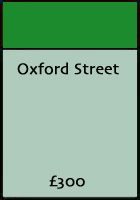London Monopoly
Although an American invention, Monopoly is a popular board game the world over. In the United Kingdom there are a number of Monopoly games available, but easily the most popular version is set in the capital: London. The majority of properties represented on the Monopoly board are still in existence today and can be visited by the general public. Visiting all the spaces on the Monopoly board is a relatively common experience that many Londoners turn into an evening out, taking part in what we call a ‘Monopoly Pub Crawl.’ But with or without the drink, a journey across London’s Monopoly Board is an interesting and unique way to visit London. From those who love to travel, to those who love the game, keep up with our trip around the Monopoly Board and experience London in an entirely new way!
Part 7 – Greens
The Greens play host to London’s oldest and most luxurious shopping districts
Top Tourist Tip: On a small traffic island where Edgeware Road meets Oxford Street is a plaque marking the spot where gallows used to stand. This spot, from the 12th to the 18th centuries, was the primary location for executions in London: Tyburn – a notorious and feared location in the capital.
Famous for its’ sweeping curvature and classic design, Regent Street is so named after the Prince Regent (later King George IV), and was designed by the architect John Nash with the plan of connecting fashionableRegent’s Park to the bustling Charing Cross area nearer the Thames. Despite its’ age, the majority of the buildings now on Regent Street date from a rebuilding project completed in the 1920’s, however all buildings on the street are officially listed as being of ‘Historical and Architectural Importance.’ Upper Regent Street is dominated by All Souls Church and the BBC headquarters, whilst the rest of the road is furnished with both fashionable and famous shops such as the Apple Store and Hamley’s – the largest toy store in the world. On the first week of November every year, Regent Street becomes home to a large Christmas light display which changes design every year.
Oxford Street (£300)

Bond Street, the most expensive of the ‘greens,’ is a luxury shopping district named after Sir Thomas Bond who developed the area nearby in the 1600’s. Previously known for art and antiques galleries, today Bond Street holds the London branches of many brands such as Gucci, Louis Vuitton, Ralph Lauren, Calvin Klein and Prada, just to name a few! Bond Street also plays host to one of the most unusual statues in London; a depiction of Winston Churchill and Franklin D. Roosevelt deep in conversation on a bench. Bond Street is mentioned in novels by both Jane Austin (in Sense and Sensibility) and Virginia Woolf (in Mrs Dalloway).









